

TEC-VARIETY by Curtis J. Bonk and Elaine Khoo. Using Self-Determination Theory to Improve Online Learner Motivation. According to self-determination theory, a theory developed by Deci and Ryan, three basic psychological needs affect motivation: autonomy, competence, and relatedness.
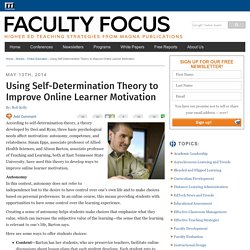
Susan Epps, associate professor of Allied Health Sciences, and Alison Barton, associate professor of Teaching and Learning, both at East Tennessee State University, have used this theory to develop ways to improve online learner motivation. Autonomy In this context, autonomy does not refer to independence but to the desire to have control over one’s own life and to make choices based on personal preferences. Online Design & eLearning Faculty Resources » Increase Online Student Engagement and Motivation Using TEC-VARIETY. Online instructors at varying levels of experience are constantly challenged by the feat of motivating and engaging students.

While most instructors do a fine job at keeping students engaged in a face-to-face course, many stumble when it comes to maintaining the same level of engagement in an online environment. If you are one of those who battle the distance and lack of physical contact in your course, take a look at this research-based resource. Adding Some TEC-VARIETY is a great resource for new and existing online instructors looking to engage and motivate their students. The book is available on the website of the same name tec-variety.com and is licensed under a Creative Commons License. v10n2dixson.pdf. Improving-Student-Engagement-white-paper. SAMPLE Discussion Participation Rubric. Using Rubrics to Grade Online Discussions - ELC Support. A rubric is a scoring scale used to evaluate a student's work.

Rubrics spell out to students exactly what is expected of them, and they list the criteria instructors use to assess students' work. Rubrics also help instructors by providing guidelines for more objective grading. The Value of Rubrics Rubrics are useful for assessing work in any classroom setting, but they are especially helpful in online courses, where all information must be clearly stated in course documents. In some courses, instructors use rubrics for each assignment.
Examples. Improving student engagement and participation in online classes. FF-Online-Student-Engagement-Report. Broadcast Yourself. Beer-full.pdf. Instructor Presence in the Online Classroom. Teacher Presence: A given in the face-to-face classroom (flickr - CC) Establishing instructor presence in the online classroom is one of the many challenges for the teacher in the online environment.
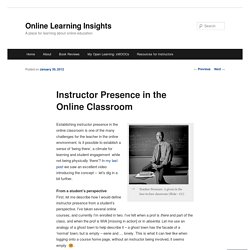
Is it possible to establish a sense of ‘being there’, a climate for learning and student engagement while not being physically ‘there’? Student Motivation and Engagement. By Selby Cull, Washington University in St.
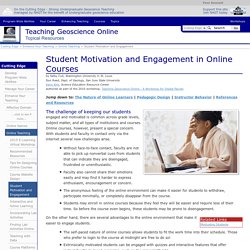
Louis Don Reed, Dept. of Geology, San Jose State UniversityKarin Kirk, Science Education Resource Center authored as part of the 2010 workshop, Teaching Geoscience Online - A Workshop for Digital Faculty Jump down to: The Nature of Online Learners | Pedagogic Design | Instructor Behavior | References and Resources The challenge of keeping our students engaged and motivated is common across grade levels, subject matter, and all types of institutions and courses. Online courses, however, present a special concern. With students and faculty in contact only via the internet several new challenges arise. COFA Online Gateway. How It Works. Badge Issuing Platforms - Badge Alliance. From the beginning of the badges work, we designed the Open Badges Infrastructure to encourage and support development throughout the community.
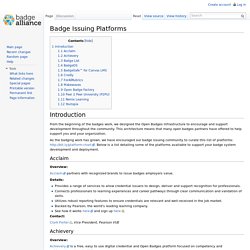
This architecture means that many open badges partners have offered to help support you and your organization. As the badging work has grown, we have encouraged our badge issuing community to curate this list of platforms: Below is a list detailing some of the platforms available to support your badge system development and deployment. Acclaim Overview: Acclaim partners with recognized brands to issue badges employers value. Details: Provides a range of services to allow credential issuers to design, deliver and support recognition for professionals. Clark Porter, Vice President, Pearson VUE Achievery Achievery is a free, easy to use digital credential and Open Badges platform focused on competency and evidence-based credentials. Built by educators and technologists in close collaboration with our users and the Open Badges Community.
Contact: BadgeOS. DropVox - Record Voice Memos to Dropbox. Using DropVox Features and Benefits Universal app, running equally well on iPhone/iPod Touch and iPad.

MP3 audio files sound great while saving bandwidth and Dropbox storage. Accessible with VoiceOver for the visually impaired. read more… Getting the Mix Right Again: An Updated and Theoretical Rationale for Interaction. Laurillard2009Thepedagogical.pdf. LTTO Episodes - Podcasts. LTTO Episodes - Online teamwork and collaboration. LTTO Episodes - Engaging and Motivating Students. LTTO Episodes - Effective online discussions. LTTO Episodes - Using wikis for collaboration.
20Geiger - Effect of student readiness on student succes in online courses. Techniques to engage the online learner. How to Motivate Students in the Online Learning Environment. “Correction does much, but encouragement does more“ Johann Wolfgang von Goethe How can course instructors encourage their online students to learn?
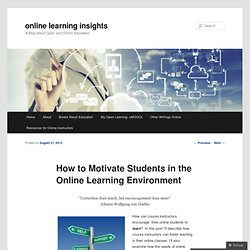
In this post I’ll describe how course instructors can foster learning in their online classes. I’ll also examine how the needs of online learners differ from students of traditional learning and how instructors and institutions can support non-traditional students. This is the third post in a four-part series on strategies for online instruction. Using Self-Determination Theory to Improve Online Learner Motivation. Written by: Rob KellyPublished On: April 12, 2014 According to self-determination theory, a theory developed by Deci and Ryan, three basic psychological needs affect motivation: autonomy, competence, and relatedness.
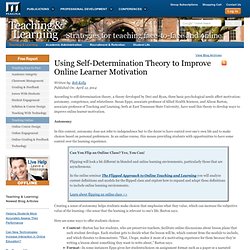
Susan Epps, associate professor of Allied Health Sciences, and Alison Barton, associate professor of Teaching and Learning, both at East Tennessee State University, have used this theory to develop ways to improve online learner motivation. Autonomy In this context, autonomy does not refer to independence but to the desire to have control over one’s own life and to make choices based on personal preferences. In an online course, this means providing students with opportunities to have some control over the learning experience. Creating a sense of autonomy helps students make choices that emphasize what they value, which can increase the subjective value of the learning—the sense that the learning is relevant to one’s life, Barton says. Competence Relatedness Reference. Student Motivation and Engagement. Instructor Presence in the Online Classroom. Teacher Presence: A given in the face-to-face classroom (flickr - CC) Establishing instructor presence in the online classroom is one of the many challenges for the teacher in the online environment.
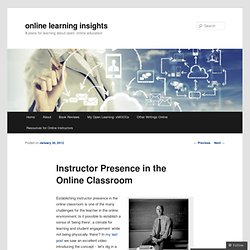
Is it possible to establish a sense of ‘being there’, a climate for learning and student engagement while not being physically ‘there’? In my last post we saw an excellent video introducing the concept - let’s dig in a bit further. From a student’s perspective First, let me describe how I would define instructor presence from a student’s perspective. I’ve taken several online courses, and currently I’m enrolled in two. The online classroom without instructor presence - similar to a Ghost Town (istock image) This sense of non-instructor involvement can be somewhat unnerving for the student, and potentially overwhelming all at the same time. 5 Proven Ways to Engage Students In Your Classroom. The eyes roll back, the mouth scowls, the fingers grip the not-so-secretly hidden cellphone, and the brain checks out. These are, as teachers everywhere can attest, the surefire signs of a disengaged student. And these symptoms are ravaging the educational system. Teachers know that student engagement is the key to learning retention and having a great overall classroom experience, but they often don’t have the time or energy to come up with some of the outrageous things that they see other teachers doing online to keep kids’ interest.
Some of us just can’t plan a flash mob for every lesson. Disengaged students are unmotivated to complete their work, apathetic about learning outcomes, and resistant to participating in classwork. Everyone has suggestions for improving student engagement. SAMPLE Discussion Participation Rubric. Parisio - Engaging students in learning through online discussion. Facilitating Cognitive Presence in Online Learning: Interaction Is Not Enough - Garrison + Cleveland-Innes. Using Rubrics to Grade Online Discussions - ELC Support.